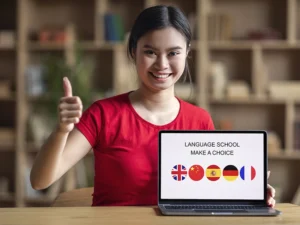We can all agree that continuous learning is essential to staying competitive in today’s global landscape. From large multinational corporations to educational institutions, more and more organizations are turning to eLearning platforms to train their teams or students across different countries.
However, for these initiatives to truly make an impact, literal translation isn’t enough. Online training must be adapted to the language, culture, and context of each audience. A course that’s effective in one region might fail to resonate in another if it hasn’t been properly localized.
This explains why the demand for eLearning translation has grown exponentially in recent years. The rise of remote work accelerated digital transformation, and the expansion of businesses into new markets have turned eLearning content translation into a strategic tool for global growth and competitiveness.
In addition, if you’re developing online content in multiple languages, we recommend exploring our web translation and localization solutions to ensure a multilingual experience that’s consistent, effective, and aligned with your brand identity across all markets.
eLearning Translation vs. eLearning Localization
Although these terms are often used interchangeably, translating eLearning content and localizing it are not the same. Translation focuses on converting text from one language to another, while localization goes a step further: it adapts the entire course to the cultural, technical, and visual context of the target audience.
Which one do you think provides a better learning experience?
Localization translates, adapts, and connects. In the world of eLearning translation and localization, this distinction is critical. A course that’s merely translated can feel confusing, inconsistent, or even inappropriate in other markets. Localization, on the other hand, ensures that the message is clear, relevant, and engaging for every audience, no matter where they are.
Why eLearning content translation matters
Translating online training programs isn’t just about overcoming language barriers—it’s also an investment in inclusion, performance, and scalability. Here are some of the main reasons why eLearning translation services are becoming indispensable for global organizations:
- Global reach and market expansion: Translating your courses allows you to reach new markets without rebuilding your content from scratch. When your eLearning programs are available in multiple languages, you can reach multicultural teams and international learners through a single platform, maximizing your global reach and impact.
- Better comprehension and knowledge retention: People learn best in their native language. In fact, studies show that 76% of users prefer to read online content in their own language. High-quality eLearning content translation helps learners understand complex concepts more easily, engage more actively, and retain information more effectively.
- Regulatory compliance: In sectors such as healthcare, law, or finance, training programs must comply with local regulations. Professional eLearning translation and localization ensure that your content is accurate, up to date, and fully aligned with the legal and regulatory standards of each market in which your organization operates.
- Inclusion and equity: Offering training in several languages sends a clear message: every employee, student, or participant matters, regardless of their language. Providing access to courses in multiple languages promotes a sense of belonging, supports a culture of inclusion, and improves the overall learner experience.
- Long-term cost efficiency: While the initial investment in eLearning translation services or localization may seem high, it quickly proves cost-effective. It allows you to repurpose and adapt existing materials, reduces communication errors, prevents misunderstandings, and improves the overall efficiency and return on investment of your training programs.
5 essential aspects in eLearning translations
To make eLearning translation truly effective, there are several factors to consider beyond simply converting text into another language. These five elements are key when planning or managing a multilingual eLearning project:
1. Type of content
eLearning materials come in many formats, such as text, videos, audio, infographics, interactive quizzes, simulations, subtitles, or voiceovers, and each one requires a specific translation approach. For example:
- Videos may need subtitling or dubbing in the target language.
- Presentations often need visual adjustments to maintain balance and clarity.
- Quizzes and assessments must preserve their level of difficulty.
2. Technical language and tone
Maintaining consistent terminology is crucial, especially in technical, medical, or legal training. It’s equally important to adapt the tone and style of the course to the subject matter and audience. A corporate onboarding module shouldn’t sound the same as a cybersecurity course, a customer service training, or a lesson on emotional wellness. The tone should match both the learning objectives and the company culture.
3. Design adapted for multilingual reading
Languages differ not only in vocabulary but also in structure and length. Some, like German, produce longer sentences, while others, like Arabic or Hebrew, read from right to left. These variations can affect the layout and appearance of your course. The design of your eLearning program should be flexible enough to accommodate longer text, right-to-left reading, and variations in date or time formats, all without disrupting usability or visual appeal.
4. Interaction and accessibility
An effective eLearning course isn’t just informative, it’s interactive. All interactive elements, such as buttons, menus, pop-ups, and forms, must be translated and tested to ensure that they work correctly in every language version. It’s also essential to meet accessibility standards so that learners with visual or hearing impairments can fully participate. This includes offering closed captions, transcripts, and compatibility with screen readers in all versions.
5. Linguistic validation and quality assurance
Translation alone isn’t enough. It must also be reviewed and validated. A dedicated review and testing phase ensures that all content is accurate, functional, and culturally appropriate. At Linguaserve, this step is carried out by professional linguists and native-language validators who perform detailed linguistic and technical checks to guarantee the highest quality.
eLearning translation is no longer a luxury—it’s a necessity for any organization with a global vision. Whether you’re training employees in different countries, launching an international educational platform, or meeting local compliance requirements, professionally translating eLearning content, and adapting it to each culture is key to achieving meaningful results.
If you’re planning to expand your online training into new markets, Linguaserve can help you do it with accuracy, consistency, and quality. From eLearning translation of individual courses to full localization of LMS platforms, we’re ready to make sure your message reaches learners everywhere with clarity, impact, and cultural authenticity.



